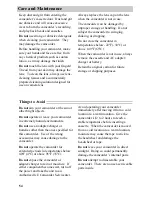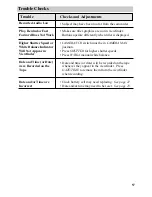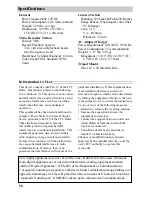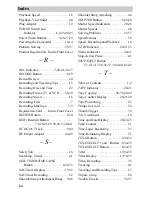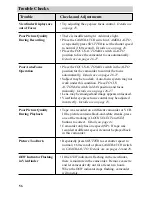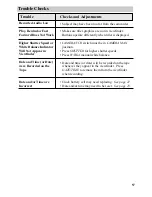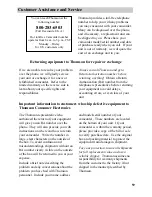
Specifications
58
General
Power requirement: 12VDC
Power consumption: 10.5 watts (normal)
Weight: 5.28 lbs. (2.4 kg)
Dimensions: 3.8"(W) x 8.3"(H) x
15.8"(D) (97 x 211 x 401 mm)
Video Recorder Section
Format: VHS
Record/Playback System:
Two video record/playback heads
One flying erase head
Headwheel Cylinder Diameter: 62 mm
Video Signal: EIA Standard NTSC
Color
Camera Section
Scanning: 525 Lines/60 Fields/30 Frames
Image Sensor: One integral color filter
CCD Imager
Lens: 1:12
5.4 ~ 64.8mm
Diameter: 52 mm
AC Adapter/Charger
Power Requirement: 100-240 V, 50/60 Hz.
Power Consumption: 35 watts (nominal)
Weight: 1.13 lbs. (513 g)
Dimensions: 3-3/11" (W) x 2-5/11" (H)
x 7"(D) (83 x 62 x 177 mm)
Tripod Mount
One 1/4" x 20 threaded hole
This device complies with Part 15 of the FCC
Rules. Operation is subject to the following
two conditions: (1) This device may not cause
harmful interference, and (2) this device must
accept any interference received, including
interference that may cause undesired
operation.
This equipment has been tested and found to
comply with the limits for a Class B digital
device, pursuant to Part 15 of the FCC Rules.
These limits are designed to provide
reasonable protection against harmful
interference in a residential installation. This
equipment generates, uses, and can radiate
radio frequency energy and, if not installed
and used in accordance with the instructions,
may cause harmful interference to radio
communications. However, there is no
guarantee that interference will not occur in a
This digital apparatus does not exceed the Class B limits for radio noise emissions
from digital apparatus as set out in the interference-causing equipment standard
entitled “Digital Apparatus”, ICES-003 of the Department of Communications.
Cet appareil numérique respecte les limites de bruits radioélectriques applicables aux
appareils numériques de Classe B prescrites dans la norme sur le matériel brouilleur:
“Appareils Numériques”, NMB-003 édictée par le ministre des Communications.
Information to User
particular installation. If this equipment does
cause harmful interference to radio or
television reception, which can be determined
by turning the equipment off and on, the user
is encouraged to try to correct the interference
by one or more of the following measures:
• Reorient or relocate the receiving antenna.
• Increase the separation between the
equipment and receiver.
• Connect the equipment into an outlet on a
circuit different from that to which the
receiver is connected.
• Consult the dealer or an experienced
radio/TV technician for help.
Changes or modifications not expressly
approved by the manufacturer may void the
user’s FCC authority to operate this
camcorder.











